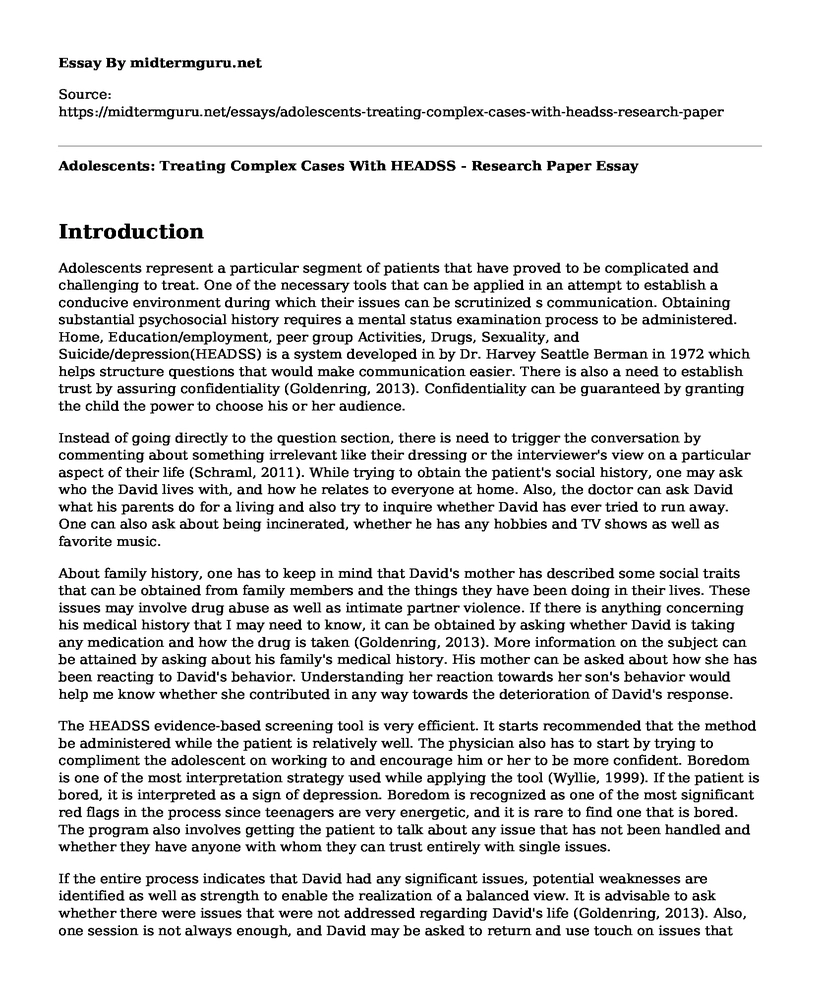Introduction
Adolescents represent a particular segment of patients that have proved to be complicated and challenging to treat. One of the necessary tools that can be applied in an attempt to establish a conducive environment during which their issues can be scrutinized s communication. Obtaining substantial psychosocial history requires a mental status examination process to be administered. Home, Education/employment, peer group Activities, Drugs, Sexuality, and Suicide/depression(HEADSS) is a system developed in by Dr. Harvey Seattle Berman in 1972 which helps structure questions that would make communication easier. There is also a need to establish trust by assuring confidentiality (Goldenring, 2013). Confidentiality can be guaranteed by granting the child the power to choose his or her audience.
Instead of going directly to the question section, there is need to trigger the conversation by commenting about something irrelevant like their dressing or the interviewer's view on a particular aspect of their life (Schraml, 2011). While trying to obtain the patient's social history, one may ask who the David lives with, and how he relates to everyone at home. Also, the doctor can ask David what his parents do for a living and also try to inquire whether David has ever tried to run away. One can also ask about being incinerated, whether he has any hobbies and TV shows as well as favorite music.
About family history, one has to keep in mind that David's mother has described some social traits that can be obtained from family members and the things they have been doing in their lives. These issues may involve drug abuse as well as intimate partner violence. If there is anything concerning his medical history that I may need to know, it can be obtained by asking whether David is taking any medication and how the drug is taken (Goldenring, 2013). More information on the subject can be attained by asking about his family's medical history. His mother can be asked about how she has been reacting to David's behavior. Understanding her reaction towards her son's behavior would help me know whether she contributed in any way towards the deterioration of David's response.
The HEADSS evidence-based screening tool is very efficient. It starts recommended that the method be administered while the patient is relatively well. The physician also has to start by trying to compliment the adolescent on working to and encourage him or her to be more confident. Boredom is one of the most interpretation strategy used while applying the tool (Wyllie, 1999). If the patient is bored, it is interpreted as a sign of depression. Boredom is recognized as one of the most significant red flags in the process since teenagers are very energetic, and it is rare to find one that is bored. The program also involves getting the patient to talk about any issue that has not been handled and whether they have anyone with whom they can trust entirely with single issues.
If the entire process indicates that David had any significant issues, potential weaknesses are identified as well as strength to enable the realization of a balanced view. It is advisable to ask whether there were issues that were not addressed regarding David's life (Goldenring, 2013). Also, one session is not always enough, and David may be asked to return and use touch on issues that were not addressed or apply a different strategy. Various recommendations can be made to help improve David's both physical and mental health. Since rogue behavior amongst adolescents primarily originates from their brains, ictal video electroencephalogram (EEG) can be applied to identify Pseudoseizures in David's mind.
References
Goldenring, J. M., & Cohen, E. (2013). Getting into adolescent heads. Contemporary Pediatrics Available at: www. contermporaryoediatrics. mondernmedicine. Com. https://www.contemporarypediatrics.com/sites/default/files/legacy/mm/Resource-Centers/GettingintoTeensHeads.pdf
Schraml, K., Perski, A., Grossi, G., & Simonsson-Sarnecki, M. (2011). Stress symptoms among adolescents: The role of subjective psychosocial conditions, lifestyle, and self-esteem. Journal of Adolescence, 34(5), 987-996. https://scholar.google.com/scholar?hl=en&as_sdt=0%2C5&as_vis=1&q=Schraml%2C+K.%2C+Perski%2C+A.%2C+Grossi%2C+G.%2C+%26+Simonsson-Sarnecki%2C+M.+%282011%29.+Stress+symptoms+among+adolescents%3A+The+role+of+subjective+psychosocial+conditions%2C+lifestyle%2C+and+self-esteem.+Journal+of+adolescence%2C+34%285%29%2C+987-996.&btnG=
Wyllie, E., Glazer, J. P., Benbadis, S., Kotagal, P., & Wolgamuth, B. (1999). Psychiatric features of children and adolescents with pseudoseizures. Archives of pediatrics & adolescent medicine, 153(3), 244-248. https://jamanetwork.com/journals/jamapediatrics/fullarticle/345648.
Cite this page
Adolescents: Treating Complex Cases With HEADSS - Research Paper. (2023, Jan 26). Retrieved from https://midtermguru.com/essays/adolescents-treating-complex-cases-with-headss-research-paper
If you are the original author of this essay and no longer wish to have it published on the midtermguru.com website, please click below to request its removal:
- Essay on the Fourth Amendment and Profiling
- Explanatory Synthesis on Sleep Deprivation
- Prostitution Recidivism - Essay Sample
- Values in Social Work: Professionalism, Ethics, and Respect - Essay Sample
- Illegal Immigrants in the US: Contributions and Challenges - Essay Sample
- Strengths and Weaknesses of Professional Accountability in Nursing - Essay Sample
- Nursing Practicum: From Novice to Expert - Essay Sample







